Beijing
We spent a day (October 8) by ourselves in Beijing before joining the tour group.
Friday October 7
When we arrived in Beijing from Ulaanbaatar, we took a taxi with a meter to the hotel, as recommended by the program director (Sally). We stayed in the Radisson Blu Hotel Beijing in a very nice room.
Saturday October 8
Upon Sally’s recommendation, we visited Jingshan Park, Beihai Park, and the Bar Street in Hutong.
We climbed 277 steps to the top of the hill in Yingshan. We could see the Forbidden City from here. There was a big Buddha inside a temple. There were lots of folks with selfie sticks taking pictures.
We had soup on Bar Street, which had solid rows of restaurants. We overlooked a little lake.
It was a challenge getting a taxi to go back to the hotel. We watched some other folks hail a taxi and duplicated what they did. We were so glad Sally printed out Chinese names of all the places, as very few people spoke English. We had the printed Chinese name of the hotel.
That evening we met the folks that were to be on our tour, along with Sally, our program director, and Tony, the local guide for Beijing. In each city, we had a local guide who knew the territory quite well.
Sunday October 9
We piled into a bus in the morning, and started our tour. The first stop was the Temple of Heaven. It was built in 1420 during the Ming dynasty to offer sacrifices to heaven and for a successful harvest. There are a number of buildings, gardens, and pathways that comprise the temple, and whose organization symbolizes the relationship between Earth and Heaven. This layout influenced Chinese architecture and planning for centuries.
We noticed here and throughout the China tour, that there is so much mysticism in the Chinese culture. There is a fascination with odd numbers; in many hotels there is no 14th floor (14 is an unlucky number); the statues of dragons are to scare away the evil spirits; etc.
We had lunch with 10 at a big round table with a big lazy Susan in the middle. This was to be the standard setup for our meals for the rest of the China tour, and usually at restaurants that catered to tourist groups. There were several groups eating at the restaurant. John and Suzanne used chopsticks for the entire meal.

The next stop was the Summer Palace. It was the former summer retreat for the Imperial family during the late Qing Dynasty and now China’s largest and best-preserved royal garden. It has an 800-year history, and comprises 12 square miles.
The Long Gallery, more than 2,300 feet long, has paintings depicting Chinese legend, history, and natural settings.

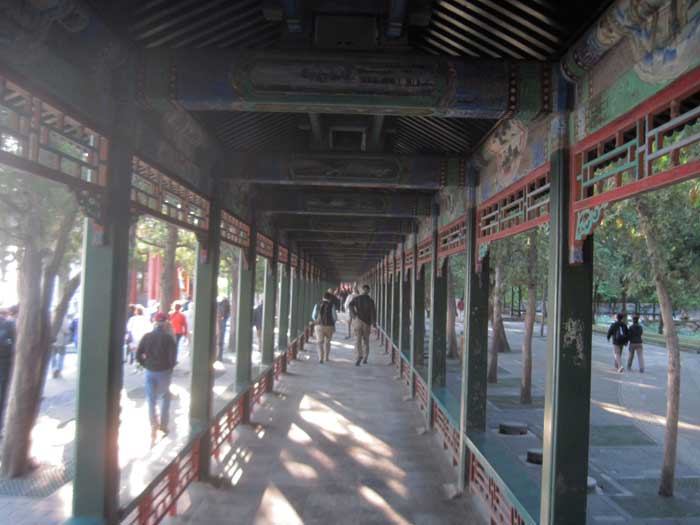
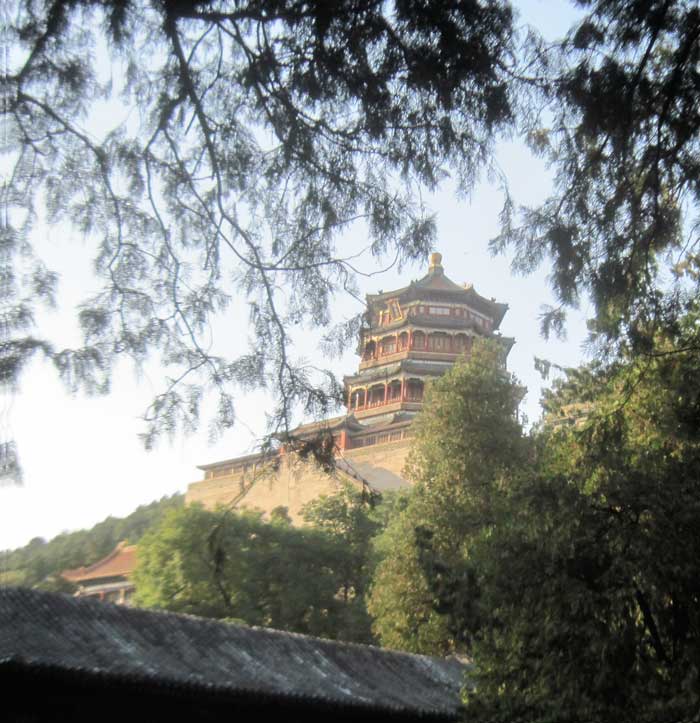


That evening we had our welcoming dinner, treating us to Peking duck (which has a lot of fat in it). To the right of Suzanne is our tour director Sally.

Monday October 10
Our first stop was a Jade Factory, where we learned about different types of jade and saw some craftsmen demonstrating their work. Of course there was a big showroom, where you could buy jade to your heart’s content. John is standing beside one big piece of jade. We saw a jade craftsman carving a ball in a ball in a ball, all jade.
We hated the pesky sales ladies who followed us closely as we looked at the jade products.


Great Wall Of course this was one of the highlights of the entire tour. It was begun during the Warring States period (403-221 BC) with sections built in scattered areas. It was only following China’s unification under the first emperor Qin Shi Huangdi (221-206 BC) that some 300,000 men were conscripted and put to work connecting the segments into one rampart of brick, stone, and earth nearly 4,000 miles long. Originally built in sections to protect various provinces from northern tribes, the wall’s construction ranges from brick-and-mortar to earthen ramparts.
Each of the wall’s great stone towers could garrison hundreds of soldiers. The towers are built at a distance of two bowshots apart – meaning that the entire wall could be defended by archers within it.
The wall snakes along a winding path because Chinese mythology maintains that demons and evil spirits can only travel in a straight line, and the undulating wall effectively keeps them out.
We climbed up to the fourth Tower on the South Gate, an ascent from where we started of about 200 meters. Along the way, a young Chinese man wanted to take a picture of us with his girl friend. So we let him. I guess they were fascinated by us Caucasians.
There were lots of souvenirs for sale. We didn’t like negotiating prices, so we didn’t buy anything.





We went to a performance at a local Kung Fu school. Their acrobatics and dances with swords and poles was amazing. The school has more than 1,000 students at this location, ranging from 3 to 19 years old.

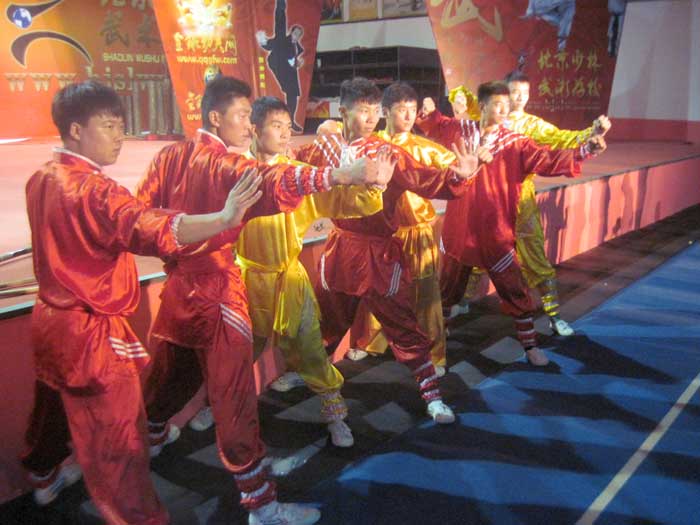
Tuesday October 11
Tiananmen Square
We were overwhelmed at the thousands of people lined up to view the Mao Zedong Mausoleum, which contains the embalmed remains of Mao. Most of them were Chinese Nationals from parts of China. They come every day in unending streams of people. There were young army sentries all around the square, standing stiffly at attention, periodically turning 90 degrees or marching off in a straight line. Many people had their pictures taken with the picture of Chairman Mao. And so did our group!



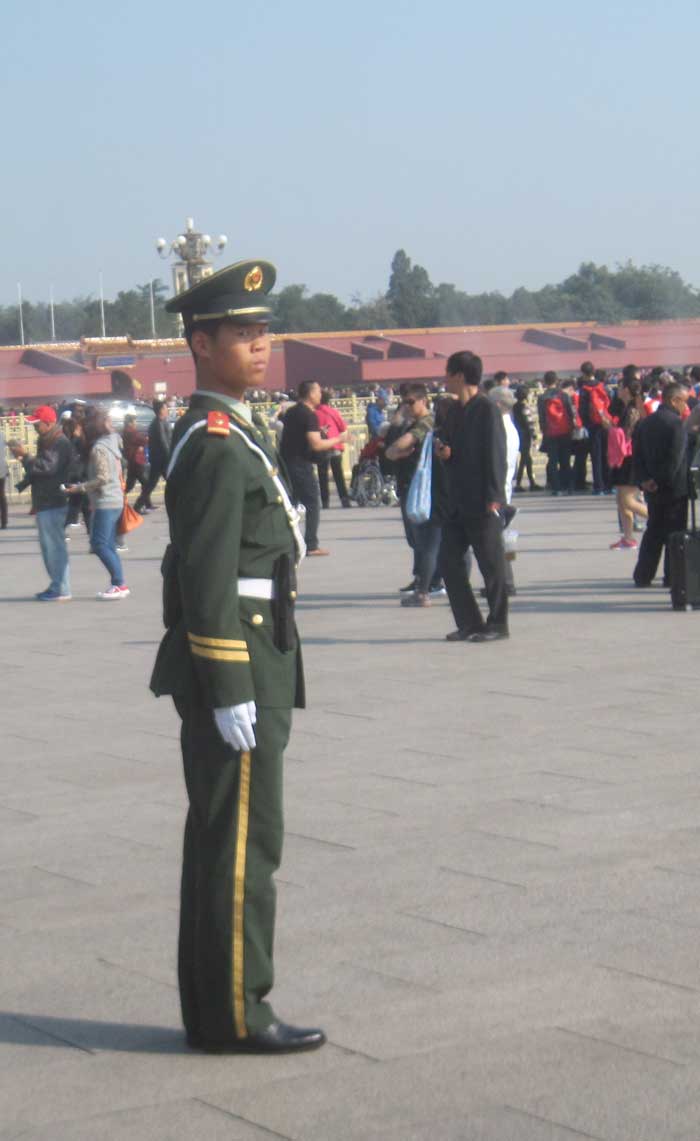


Forbidden City
The city was so named because it was off limits to visitors for 500 years. The city contains 800 ceremonial buildings, of which we saw just a few. It was completed in 1420, and was the center of imperial palaces for the emperors of the Ming and Qing dynasties. The main courtyard can hold 100,000 people.






The Chinese have a fascination with odd numbers. On the corners of the roofs are a line of figures, and there is always an odd number. Here are nine of them lined up on each corner.

Hutongs and Rickshaw Ride
The word hutong refers to the narrow lanes created by the walled residential compounds built one on top of another in the cramped districts in the residential areas near the capital. About half the population of Beijing lives in hutongs. We took a rickshaw ride through one of the hutongs. It was powered by a man pedalling a bicycle.



We visited a home where a woman earns a living by painting inside little bottles and selling them. Here is one we bought.
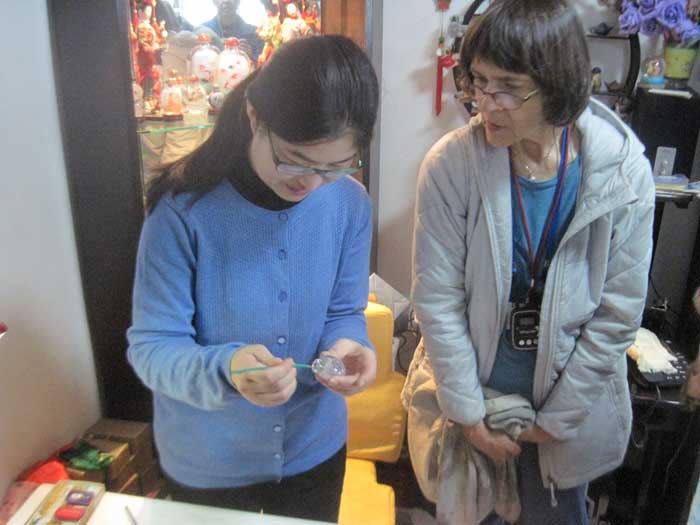

Wednesday October 12
This morning we went to a cloisonné factory to learn about the process of creating the pieces. It was dark, dank, and depressing. Of course, there was an associated showroom.


Here is a picture of one of the several buses we rode during the trip. They were comfortable and clean, and we rotated seats every day so that everyone got a chance to be by the “good” windows.

That afternoon we flew to Shanghai. Everywhere we went, especially in a crowded airport, we kept our eye on the stick with the flags of five colors that our program director, Sally, would hold in the air. We stayed in the Ramada Plaza Peace Hotel.

To continue our trip, go to the Shanghai page.
